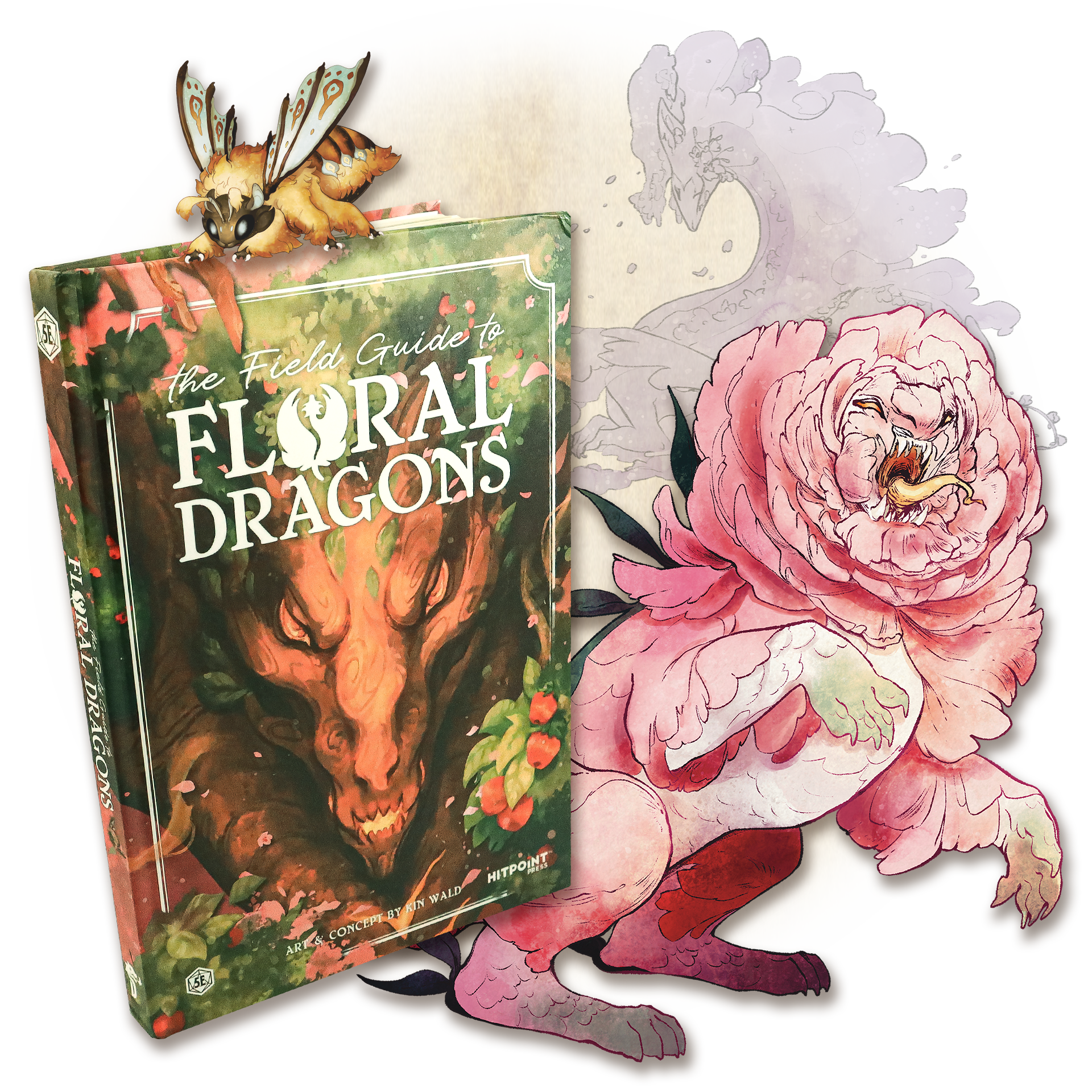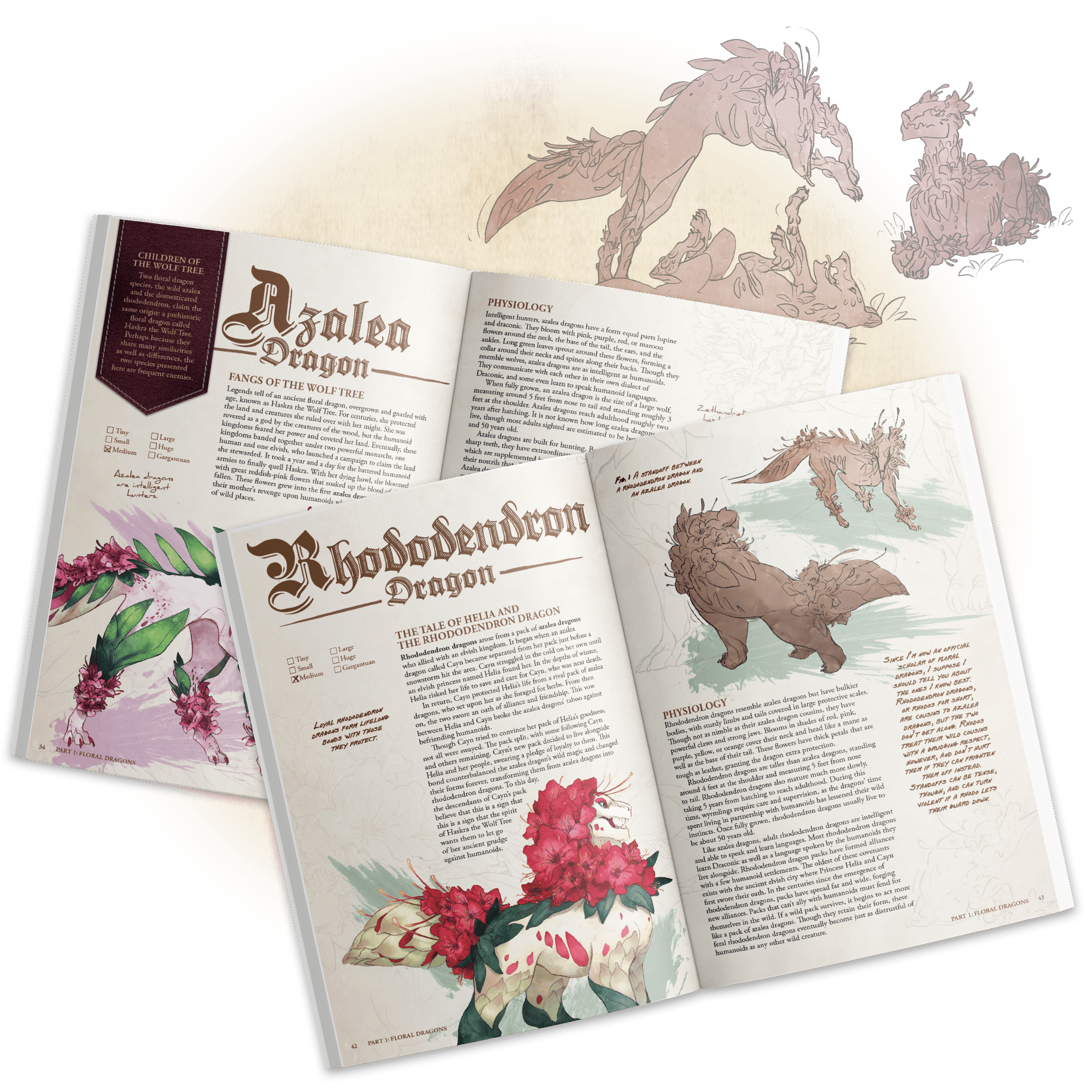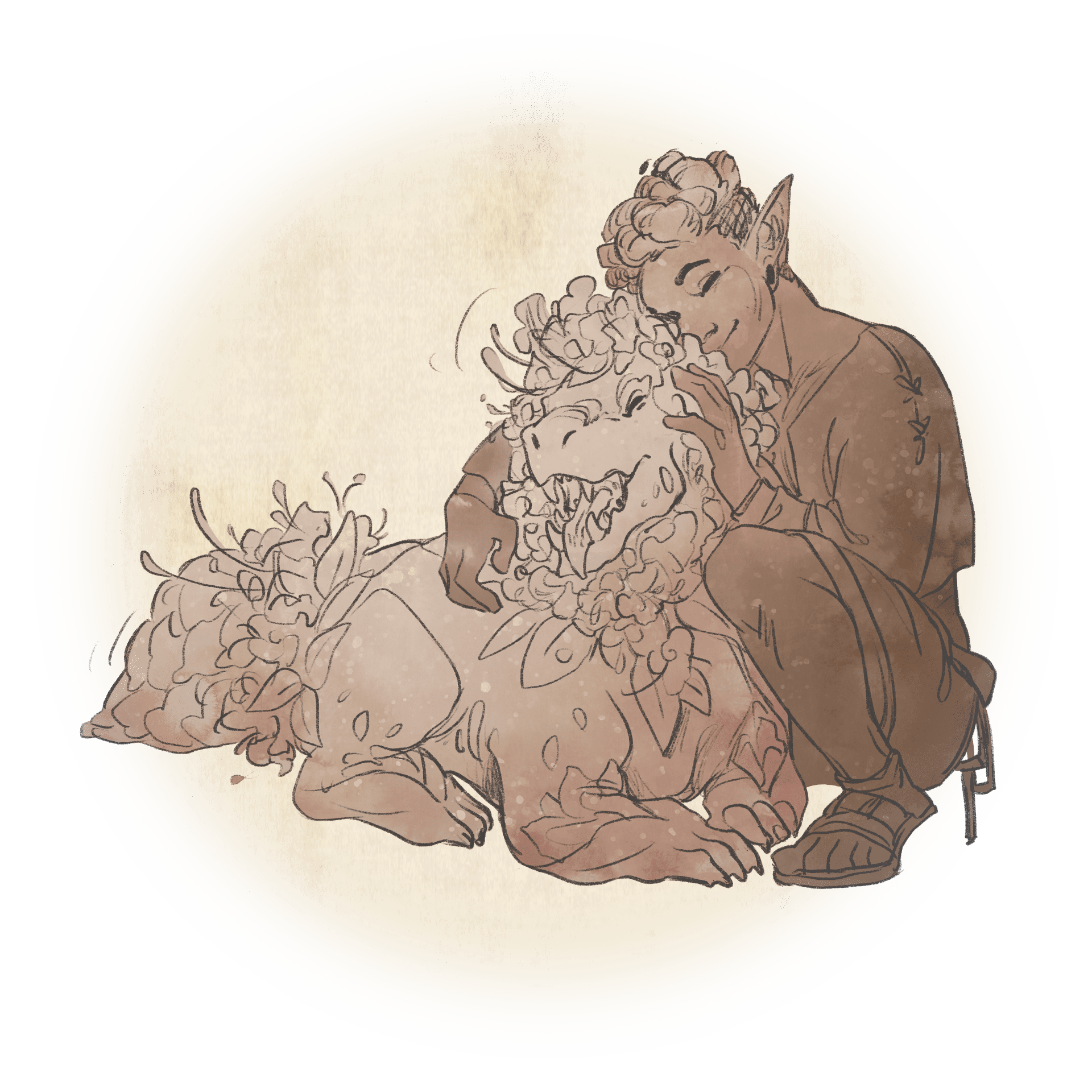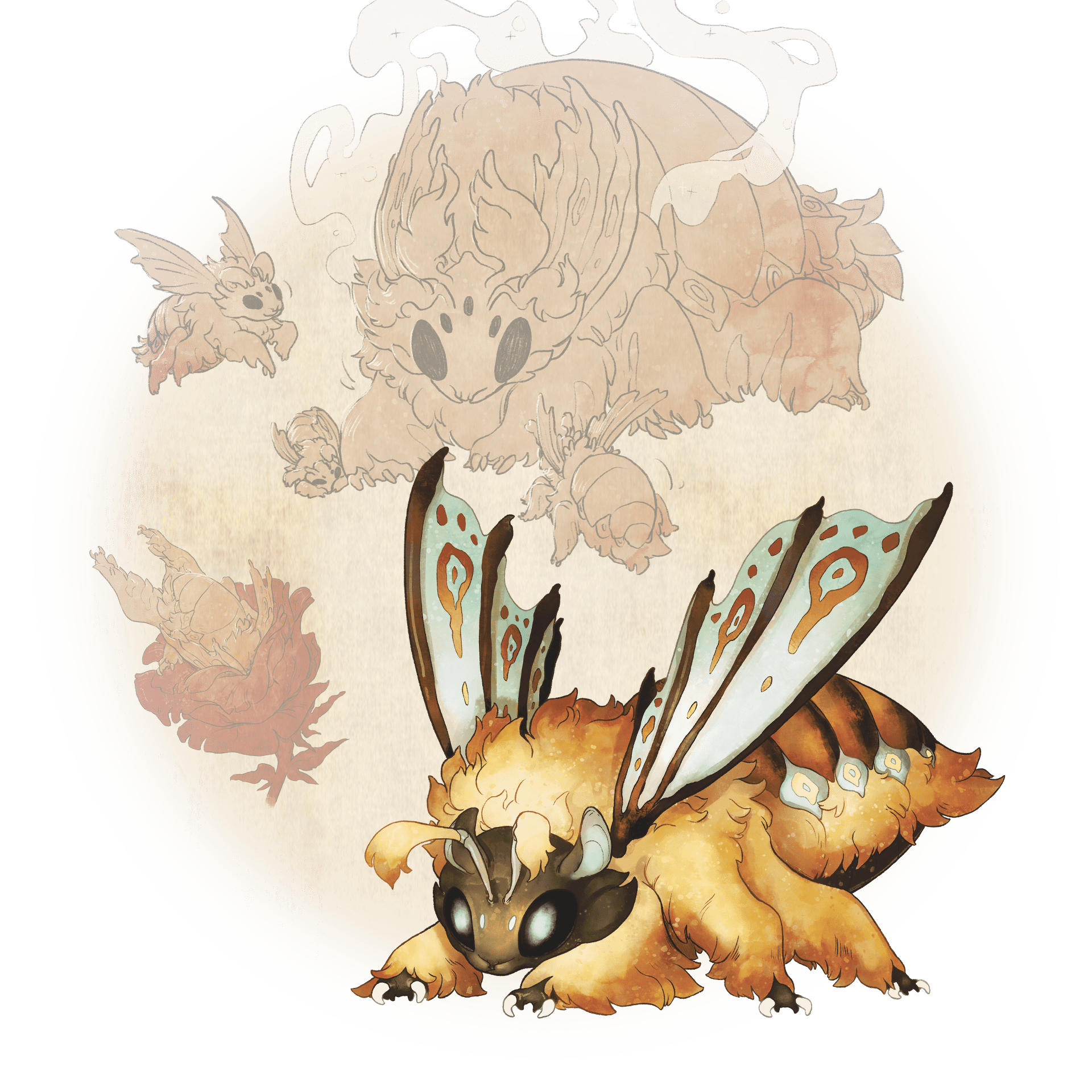No single creature better embodies danger, excitement, and adventure than the dragon. Since ancient times they’ve stood as the apex of fantasy, whether as the biggest and baddest monster to be slain or the wisest and most elusive magical creatures of myth. But despite all that time they’ve retained the same basic elements: big, scaly, sharp teeth, breathe something. But artist and creature designer Kin Wald thought more could be done, and partnered with Hit Point Press to create The Field Guide To Floral Dragons. Modeled after a real life zoological or botanical guide book, it features a true garden of new dragons for GM’s of any sort to use to bring some fun floral flavor to their next campaign.
We got a chance to talk to Brian Walters, the book’s Art Director, and Verity Lane, one of the book’s writers, about the floral husbandry of dragons and how they went about tending to this garden.

How did Hit Point Press connect with Kin on this book and what made the Floral Dragons stand out as a project?
Kin had been developing Floral Dragon pieces for a bit and approached Hit Point to see if it was something we were interested in developing rules around. Luckily, we had some time and design space, and there was a boom of interest in roleplaying supplements during the COVID lockdown so we agreed to work on the book together. Kin would be providing all the art for the book and we would take any notes Kin had as we developed the content.
Floral Dragons stands out to me because there are so many different ways it appeals to people. Like Dragons? We got those. Like flowers? Those too. Like deep lore and story? We got you. Play D&D? We have rules for all these creatures. Like amazing art? So do we, so we put a bunch in the book.
Why did you choose to format this book as a Field Guide?

Both Kin and the team at Hit Point Press were inspired by fantastic books from our childhoods like Dragonology. There’s something really delightful about books that treat their fantastical subject matter in an earnest and serious way. We wanted to evoke the feeling that you’ve somehow picked up a book from another world where these floral dragons are real. The field guide format is a window into that world that you can curl up with and escape to.
How did you go about capturing the voice and feel of a field guide?
We wanted to go in-depth into the behavior, environment, and physiology of the dragons, really describing them in the way you would expect from a field guide. Alongside that, we added field notes from our “floral dragon research team” characters, which give a more casual and personal take on the dragons. These field notes also let us add a hidden story within the book. Dedicated readers will be able to piece together the order of events and how things align with the creation of the mushroom dragon.
How do you go about pairing up dragons with their floral elements?

There was a lot of back and forth between the team and Kin as we were developing the book. We knew we wanted a wide variety of creature types and sizes and that was a big starting point. Kin would pick a flower they had an idea for and we would discuss a creature that might fit. Several like the Jade Vine Dragon which Kin knew immediately was an upside-down hanging bat-like creature. I originally thought it would be a big intimidating bat but Kin did this sketch for it that fit so well on a smaller scale, so we adjusted the size.
What makes these dragons stand out from “ standard” fantasy dragons?
The big thing for The Field Guide To Floral Dragons was that they aren’t all going to fit into your prototypical dragons. We have a few that fit into the more European-style reptile dragons like the Ornithogalum Dragon or the Asian-influenced dragons like the Cherry Blossom dragon. They exist in an ecosystem filled with other floral dragon creatures like the Aconite which is based on a chameleon or the Azalea which is very wolf-like.
How do you balance the natural beauty of these dragons with the sort of danger and menace that comes with them?

Nature definitely took the lead on this! So many plants are beautiful and deadly so they provide great inspiration. For example, wisteria vines can strangle other plants and even pull down buildings. We incorporated that power into the Wisteria Dragon, which enjoys strangling its foes and destroying entire towns. Beautiful definitely doesn’t equal safe in the world of floral dragons!
How do you come up with anatomy, behavior, and botany that feels real but is about totally fictional creatures? How do you mix the “real” with the fantastic?

The fantastic feels more real when you ground it in the real. We try to think about these creatures as living beings, asking ourselves how they live, breed, and exist in the world. A lot of this comes from research into real animals. Once we’ve got a solid base, we can start to build the fantastical on top of that. In some places, we blended plant biology with animal biology, such as the Ornithogalum Dragon’s eggs which are inspired by flower bulbs and alligator eggs. Even when we bring in magic, we try to make it work with the biology of these creatures rather than against it.
What sorts of stories do you envision for the Floral Dragons?
We tried to cover a wide range of story beats with the different dragons. Of course, they will fit in well in stories set in the wilderness but also in stories where people and nature come into conflict. There’s also a strong environmentalist theme throughout the whole book, so stories that tackle the question of how we can live with nature rather than simply exploiting it will find lots of material in the book. There’s also a huge range of allies and enemies in the book. You could enjoy a lighthearted caper with some playful dandelion dragons, fight off a siege alongside a mighty apple tree dragon, or experience the horror of the mushroom dragon and its creeping corruption.
Were there any particularly challenging dragons to write or design?
Since so many plants have poison as their main defense mechanism, we had to get creative rather than just make dozens of poisonous dragons. One of our favorite twists on poison was the Ornithogalum Dragon. Ornithogalum plants are deadly to livestock and cause a lot of problems for farmers. So rather than making the dragon poisonous, we gave it a toxic aura that causes exhaustion. Livestock slowly collapses around it as this herbivorous dragon grazes alongside them. Creative constraints like this can lead to more interesting situations than if we didn’t have them.
What are some of your favorite dragons or creatures in the book?

The whole team fell in love with the vespons, the fuzzy little dragon bees that pollinate the floral dragons and make magical honey. But I also have a soft spot for the florivores. These nasty little bugs are the parasitic counterparts of the cute vespons. They latch onto floral dragons and eat their sap. Writing the lore entry for the florivores, which is an extract drawn from an ancient horticultural text, was so much fun because the author despises them. I love how they round out the ecosystem of the floral dragons, and anyone who is a gardener will recognize how hard it can be to battle against pests!
You can still back The Field Guide To Floral Dragons on its Kickstarter page, or keep an eye on it at the Hit Point Press shop and your FLGS later this year!
Images via Hit Point Press
Have strong thoughts about this piece you need to share? Or maybe there’s something else on your mind you’re wanting to talk about with fellow Fandomentals? Head on over to our Community server to join in the conversation!

